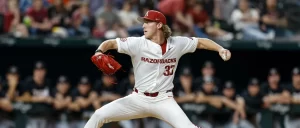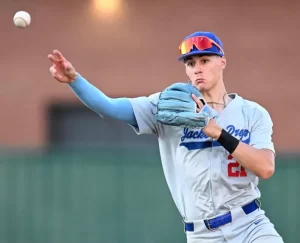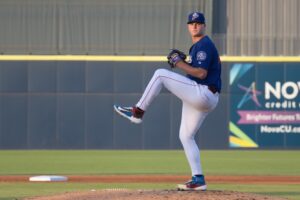Draft Preview: LHP Braxton Garrett – Florence High School (Alabama)
Braxton Garrett
School: Florence HS (AL)
Position: Left Handed Pitcher
Height/Weight: 6’3”/190 lb
B/T: R/L
D.O.B: 8/5/1997 (18 years old)
College Commitment: Vanderbilt
2016 Stats (as of May 26th, 2016) : 5-2, 11 G, 62.1 IP, 0.56 ERA, 31 hits, 12 runs, 5 earned runs, 15 BB & 125 K
Scouting Reports:
“Garret is a 6’3″ 190 pound lefty prep star out of Alabama. Scouts claim he has one of the best curveballs in this class with a fastball that sits 90-94 mph and has late life. Many say that he has the ceiling of a future No. 2 starter. He is one of the many commitments to play at Vanderbilt next year.” – Scott Moore, Fangraphs
“Garrett spins one of the best curveballs among high schoolers in the 2016 Draft class, a 76-80 mph bender with good depth, though he can fall in love with his breaking ball at times. He also throws an 88-94 mph fastball with deceptive angle and some late life. Both pitches figure to add more velocity once Garrett strengthens his athletic frame.
Garrett has feel for a changeup that has shown signs of developing into a plus pitch as he has used it more as a senior. With his loose, whippy arm and clean delivery, he shouldn’t have trouble remaining a starter in pro ball. Garrett has a ceiling of a No. 2 starter and a relatively high floor for a high school pitcher.” – MLB Pipeline
“Garrett has seen a bump in velocity since last summer when he was mostly sitting in the high-80s and occasionally creeping into the low-90s. This spring, Garrett has been sitting 90-93 mph with some sink and showing the best present curveball of any prep lefty not named Jason Groome. The curve is a true 12-6 hammer with sharp break and good depth and is consistently average now — with a chance to be plus. The changeup is a bit inconsistent and firm — it’s been up to 86 mph — but looked great at NHSI in March, and scouts who saw him there think it has a chance to be a solid average offering, if not a little better.
The arm action is just fine, quick and deceptive but not overly violent and grotesque, though sometimes Garrett’s arm comes through early and he doesn’t incorporate his lower half into his delivery as much as you’d like. When he gets his hips through with better timing, everything looks just fine.
Physically, Garrett offers a modest amount of projection, perhaps just enough to counterbalance a heavy professional workload and maintain the low-90s velocity we’ve seen this spring. He has a chance to be a mid-rotation starter and could be the second or third prep lefty off the board.” – Keith Law, ESPN.com (Insider)
Scouting Grades:
Note: These grades are summations based on available scouting information from sources such as Baseball America, MLB.com, and Fangraphs.
(Present/Future value, 20-80 scale)
Fastball: 55/60
Curveball: 60/70
Changeup: 40/55
Control: 55/60
Overall: 55/60
Prospect Overview and Future Outlook:
Garrett became well known within the baseball community early on in his high school career, as he was a four year varsity starter and star under the tutelage of his father Steve Garrett, his head coach over his entire high school career. While Garrett has been a very good hitter in the high school ranks, it was evident early on that his future would be on the mound. After going 15 and 5 with a 1.56 ERA and 216 strikeouts over 134.1 innings during his freshman and sophomore seasons, he exploded on the national scene, earning scholarships from top college programs including Vanderbilt, where he would commit shortly after his sophomore year.
After committing to a hotbed for top collegiate pitchers in Vanderbilt, Garrett showed no signs of slowing down and put up even better numbers over his junior and senior seasons at Florence High. In his junior season, the young southpaw went 7 and 1 with a 0.74 ERA, while striking out an incredible 141 batters over 66.2 innings of work. After an impressive season, Garrett went on to win a gold medal as a member of the United States U-18 team at WBSC U-18 Baseball World Cup, as well as participated in the Perfect Game All-American Game in San Diego. In his final high school season, Garrett has remained just as dominant, as he has just given up just 5 earned runs over 62.1 innings with 125 punch outs. He was also just named the Gatorade Player of the Year in Alabama for 2016 this week, which is given to the top player in every state.
When evaluating Garrett’s arsenal, his fastball sits in the low nineties with some late movement, and it can get up to as high as 94. He’s enjoyed a solid velocity boost over the last year, as he sat in the upper eighties while touching 90 at times just a year ago in 2015. What separates Garrett from the pack is his curveball, a true 12-6 deuce with a very sharp break and solid depth. Keith Law of ESPN.com says his curveball is the best in the draft class outside of another high school phenom in Jason Groome, and it has a chance to be a plus pitch in the future. His changeup has been inconsistent for him, and he throws it relatively hard in comparison to his fastball. While the changeup has lacked consistency, there have been times it has been very good and serviceable. He displayed a great changeup against other top teams across the country at the National High School Invitational in Cary, North Carolina back in March according to scouts, so there is hope that he can get more consistency on his pitch and have possibly up to three plus pitches as a professional.
Mechanically, Garrett possesses a smooth and compact delivery while adding some solid deception. After watching his outing at the Perfect Game All American-Game here, I came away impressed how sound mechanically he looked. Scouts have mentioned there are times where he does not use his lower half as well as he should, but from the footage here I thought he did a nice job incorporating his lower half and getting everything out of his body while remaining mechanically sound. I think Garrett’s motion and mechanics are very similar to Los Angeles Angels southpaw C.J. Wilson, who obviously has turned in a very nice career thus far.
Another area that stood out with Garrett was his slender frame. While he stands at 6’3” and 190 lb, I do think there is room to build on here and potentially add a couple more ticks to an already impressive fastball. This seems to be a norm for a majority of high school players in that they have not all physically matured completely, so there may be room to grow here with the young southpaw in Garrett.
As for the future outlook for Garrett, in all likelihood he has the chance to be a middle of the rotation arm with the ceiling of a number two starter. MLB Pipeline projects the young lefty as a mid-rotation arm with the ceiling of a number two, and also mentions he has a relatively high floor for a high schooler. Law on the other hand sees Hudson as a mid-rotation starter, and I tend to agree there. Hudson may not be the most eye opening prospect in this year’s draft, but he seems to be consistent and a reliable bet as a first round selection. While his curveball has elite upside, everything else should be relatively average at the professional level. He will be 18 years old on draft day, and that would give teams plenty of time to develop him, which will benefit him greatly. What I like most about Garrett is that he still has room to build from a physical standpoint, which in turn can mean an even stronger arsenal in the future. There has been a strong reluctance as of late to draft high school pitchers early in the draft due to a variety of reasons, but Garrett may be an outlier here, as he has shown the ability to be a solid professional early on in his young career.
Draft Day:
There is no question that Garrett will go in the first round, with some seeing him as a top ten pick while others seeing him fall to the middle of the first round. In recent mocks, Garrett is all over the board, as one has him going as high as eighth whereas another has him being selected at 16th. In his first mock draft, Keith Law has Garrett going to the San Diego Padres as the eighth selection, while Scott Moore of Fangraphs has the lefty falling to the Los Angeles Angels at 16 in his. MLB.com analyst Jim Callis has him landing between those two, predicting the Seattle Mariners select him at 11, one pick after the White Sox select at ten.
There is a chance that Garrett is available for the White Sox to take him at ten, but there is virtually no chance he falls to them when they select again in the first round at pick 26. It is clear that the White Sox prefer drafting college arms early, as shown by selecting Carlos Rodon third overall in 2014 followed by Carson Fulmer eighth overall in 2015. The White Sox have not selected a high school pitcher in the first round since they selected Providence Catholic’s Kris Honel 16th overall in the 2001 MLB First Year Player Draft. While it may be surprising and unlikely to see the White Sox go the high school route this year and select Garrett, they should not back off if they think he is the best player available just because he is a high schooler. The White Sox have done as good of a job as any other team in baseball developing college arms, and I’m confident they could do the same in a high school arm like Garrett.
I assume Garrett would want a deal at full slot or maybe even above, which could possibly lead to a dilemma for the White Sox. With two first round selections this year, the Sox may want to allocate their draft pool wisely and get two premier talents for a respectable amount of money. If the White Sox were to go above slot for a player they select at ten, it could potentially hurt them when they select again at 26. While I have no idea if selecting Garrett would present this scenario, it is worth keeping in the back of your mind.
Depending how you value each player, Garrett could possibly be the best talent available when the White Sox select at ten. While I think there may be better players available at ten, I could see the White Sox sticking to their norm as of late and drafting a pitcher. As I mentioned earlier, teams have shown a strong reluctance to draft a high school arm early in the draft, but if the White Sox believe Garrett is the best player available, then I would have no problem selecting him. Garrett has smooth mechanics and maintains a consistent delivery, and the White Sox are the best in baseball keeping their pitchers healthy, thus making this a potential fit. White Sox Scouting Director Nick Hostetler has mentioned in the past how he has a preference for high school players, so do not be surprised to see the Sox go outside the box and use their first selection on a high schooler like Garrett.
***Look for more profiles of potential draftees for the White Sox in the coming weeks before the draft. Here are other profiles already completed:
C Zack Collins, Miami
RHP Dakota Hudson, Mississippi State
Want to know right away when we publish a new article? Type your email address in the box and click the “create subscription” button. Our list is completely spam free, and you can opt out at any time.







